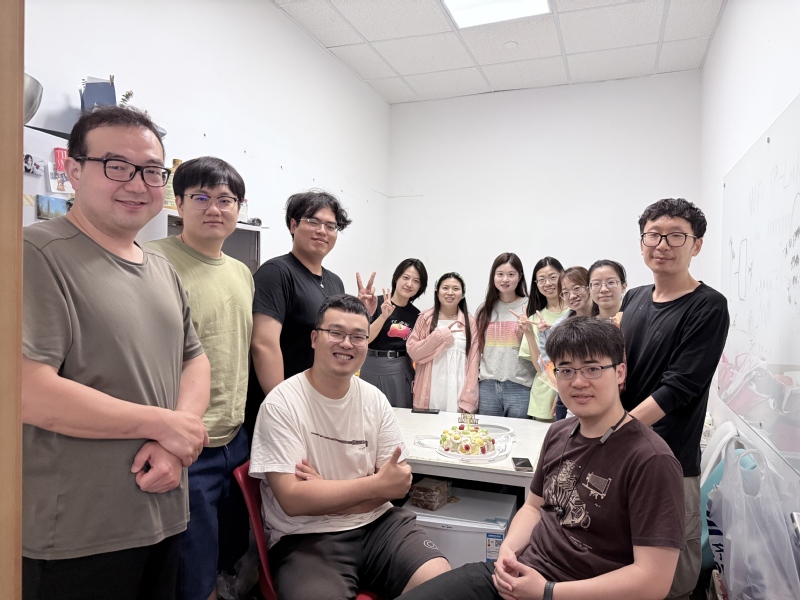Nutrient, metabolism and animal development
Principal investigator
Name:
Huanhu ZhuAssociate Professor , PhD, Associate Professor
Position:
Affiliation:
School of Life Science and Technology
Honor:
Education Background:
- 1998-2002, Fudan University CHINA, B.S.
- 2002-2010, Fudan University CHINA, Ph.D.
Working Experience:
- 2009-2015, University of Colorado Boulder, HHMI, Research associate
- 2015/11-Present, ShanghaiTech University, Assistant Professor (TENURE-TRACK)
Group Introduction
Research Area:
Environment Factors on Developmental Regulation
Research Interests:
The interplay between animal and the environment helped to shape the physiological and developmental program in animals. To better understand this process, we apply a nematode C. elegans model to study the role of several key environmental factors such as nutrient molecule, pheromone and gut bacteria. We are surprised to find those environments play vital roles and fundamentally arbitrate the animal developmental fate and the native immunity Homepage of Zhu Lab:www.zhulab-shanghaitech.com 
Research Achievement
Functions of Nutritional Molecules in Animal Development and Evolution Darwinism holds that the fundamental driving force for the existence and evolution of life forms originates from the process whereby individuals/populations strive to adapt to the external environment and reproduce themselves. We believe that the developmental programming of animals is also deeply shaped and influenced by this process. Using model organisms such as Caenorhabditis elegans (C. elegans), we primarily focus on the decisive regulatory role of nutritional factors in animal individual growth, development, and disease processes, and explore the universal paradigms within. Why use Caenorhabditis elegans?
C. elegans is an invertebrate with only 302 somatic cells, fully transparent, and hermaphroditic. Since its introduction as a model organism into molecular genetics research by Professor Sidney Brenner in the 1960s, related work (including discoveries of cell lineage, apoptosis, siRNA, miRNA, and green fluorescent protein) has earned four Nobel Prizes to date. Besides possessing powerful genetic tools, the nutritional metabolic pathways in C. elegans are highly conserved compared to humans; it is very sensitive to external nutritional conditions, capable of entering a protective dauer (arrest) state under nutrient scarcity. These characteristics are crucial for our research into the relationship between nutrition, individual development, and diseases. Research Overview: 1. Single fatty acid molecule used to evaluate overall amino acid abundance
Animals need to integrate numerous nutritional molecules into an abstract “nutritional” signal that regulates individual growth and development. The traditional view regards this as a “logical AND gate” because various essential nutrients are all necessary for the assessment. However, our study of a peculiar fatty acid widely present in humans and animals challenges this notion. We found that even under overall amino acid deficiency, supplementing with a monomethyl branched-chain fatty acid (a metabolite of branched-chain amino acids) can serve as a critical signal for amino acid abundance in the body, forcing animals to initiate development by activating mTOR, the most important nutrient-sensing pathway in eukaryotes (Zhu et al. 2021 Developmental Cell). We speculate that this “efficient” but “one-sided” mode of nutritional assessment may have evolutionary significance. 2. Nutritional “gut-brain axis” signal controlled by glucosylceramide and peroxisomal subcellular localization
How do animals achieve coordinated nutrient perception and developmental regulation across multiple organs? Regarding mTOR, the most important nutrient sensing pathway in eukaryotes, traditional biochemistry and cell biology focus mainly on its independent nutrient sensing in each cell. But as an organism with billions of cells, is such a vital nutrient state really evaluated “democratically”? In a genetic screen for downstream signals of mTOR mediated by glucosylceramide, we unexpectedly discovered a key nutrient signaling transmission pathway from the intestine to the brain. Moreover, the “unassuming” peroxisomes in the intestine, especially their subcellular localization, play a critical role in inter-organ nutrient signal transmission (Li et al. 2022 Cell Reports). Since both glucosylceramide and peroxisomes are absolutely essential for the development of multicellular organisms, we speculate that their dual positive and negative functions in multicellular developmental regulation may reflect the complex regulation of multicellular animals adapting to environmental nutrients. 3. Fatty acid molecules in nutrition as the first driving force determining animal development
The conventional view holds that the initiation of animal post-embryonic development is primarily controlled by its intrinsic genetic program, with nutrition merely serving to provide materials and energy for development. However, in screening simple nutritional molecules for development-regulating factors, we unexpectedly found that feeding free long-chain fatty acids alone—rather than glucose or amino acid mixtures (all of which can be metabolized into fatty acids in vivo)—can trigger the earliest postembryonic developmental processes in C. elegans. Furthermore, free fatty acids act as signaling molecules to initiate postembryonic development by downregulating the well-known mTOR pathway and promoting nuclear receptor activation (Ruan et al. 2024 PLOS Biology). It is worth further investigation why animals evolutionarily selected fatty acids as nutritional developmental signals. 4. “Finding happiness in bitterness” in food
Food often contains many naturally bitter molecules. Our group, in collaboration, discovered that nomilin—a limonoid compound abundant in citrus fruits and an important source of bitterness in freshly squeezed orange juice, often removed in industrial juice processing—can act as a ligand for nuclear receptors in the body. By activating detoxification pathways, nomilin extends the healthy lifespan of C. elegans and mice (Fan et al. 2023 Nature Communications). This discovery has sparked reflection on the biological significance of bitter molecules and the impact of modern food industry processing on our health.
Reference 1. Fan, S., Y. Yan, Y. Xia, Z. Zhou, L. Luo, M. Zhu, Y. Han, D. Yao, L. Zhang, M. Fang, L. Peng, J. Yu, Y. Liu, X. Gao, H. Guan, H. Li, C. Wang, X. Wu, H. Zhu, Y. Cao and C. Huang (2023). Pregnane X receptor agonist nomilin extends lifespan and healthspan in preclinical models through detoxification functions. Nat Commun 14(1): 3368. 2. Li, N., B. Hua, Q. Chen, F. Teng, M. Ruan, M. Zhu, L. Zhang, Y. Huo, H. Liu, M. Zhuang, H. Shen and H. Zhu (2022). A sphingolipid-mTORC1 nutrient-sensing pathway regulates animal development by an intestinal peroxisome relocation-based gut-brain crosstalk. Cell Reports 40(4): 111140. 3. Ruan, M., F. Xu, N. Li, J. Yu, F. Teng, J. Tang, C. Huang and H. Zhu (2024). Free long-chain fatty acids trigger early postembryonic development in starved Caenorhabditis elegans by suppressing mTORC1. PLOS Biology 22(10): e3002841. 4. Zhu, M., F. Teng, N. Li, L. Zhang, S. Zhang, F. Xu, J. Shao, H. Sun and H. Zhu (2021). Monomethyl branched-chain fatty acid mediates amino acid sensing upstream of mTORC1. Developmental Cell 56(19): 2692-2702.e2695.
Representative Publications (*First Author, # Corresponding Author)
- 1. Zhu, Mengnan*; Teng, Fukang; Li, Na; Zhang, Li; Zhang, Shuxian; Xu, Fan; Shao, Jing; Sun, Haipeng; Zhu, Huanhu#.Monomethyl branched-chain fatty acid mediates amino acid sensing upstream of mTORC1.DEVELOPMENTAL CELL. 11 Oct 2021. 56(19):2692-+.
- 2. Liu, Yalei*; Zhou, Zhenyu; Yin, Liufang; Zhu, Mengnan; Wang, Fei; Zhang, Lijun; Wang, Hongqing; Zhou, Zhiqin; Zhu, Huanhu#; Huang, Cheng#; Fan, Shengjie#.Tangeretin promotes lifespan associated with insulin/insulin-like growth factor-1 signaling pathway and heat resistance in Caenorhabditis elegans.BIOFACTORS. Mar 2022.
- 3. Wang, Feng*; Dai, Yuxi; Zhu, Xufeng; Chen, Qilong; Zhu, Huanhu; Zhou, Ben; Tang, Haiqing#; Pang, Shanshan#.Saturated very long chain fatty acid configures glycosphingolipid for lysosome homeostasis in long-lived C. elegans.NATURE COMMUNICATIONS. 20 Aug 2021. 12(1).
- 4. Zhang, Yang*; Sun, Xiaodan; Qian, Yangyang; Yi, Hongfei; Song, Ke; Zhu, Huanhu; Zonta, Francesco; Chen, Weizhong; Ji, Quanjiang; Miersch, Shane; Sidhu, Sachdev S.#; Wu, Donghui#.A Potent Anti-SpuE Antibody Allosterically Inhibits Type III Secretion System and Attenuates Virulence of Pseudomonas Aeruginosa.JOURNAL OF MOLECULAR BIOLOGY. 06 Dec 2019. 431(24):4882-4896.
- 5. Mao, Shaoshuai*; Qi, Yingchuan; Zhu, Huanhu; Huang, Xinxin; Zou, Yan; Chi, Tian#.A Tet/Q Hybrid System for Robust and Versatile Control of Transgene Expression in C. elegans.ISCIENCE. 25 Jan 2019. 11:224-+.
- 6. Zhu HH(朱焕乎)#*.Current advances in the functional studies of fatty acids and fatty acid-derived lipids in C. elegans.WORM. 04 May 2016.
- 7. Zhu, Huanhu#*; Sewell, Aileen K.*; Han, Min.Intestinal apical polarity mediates regulation of TORC1 by glucosylceramide in C. elegans.GENES & DEVELOPMENT. 2015. 29(12):1218-1223.
- 8. Kniazeva, Marina#*; Zhu, Huanhu; Sewell, Aileen K.; Han, Min#.A Lipid-TORC1 Pathway Promotes Neuronal Development and Foraging Behavior under Both Fed and Fasted Conditions in C. elegans.DEVELOPMENTAL CELL. 2015. 33(3):260-271.
- 9. Zhu, Huanhu#*; Han, Min.Exploring Developmental and Physiological Functions of Fatty Acid and Lipid Variants Through Worm and Fly Genetics.ANNUAL REVIEW OF GENETICS. 2014. 48:119-148.
- 10. Zhu, Huanhu*; Shen, Huali; Sewell, Aileen K.; Kniazeva, Marina; Han, Min#.A novel sphingolipid-TORC1 pathway critically promotes postembryonic development in Caenorhabditis elegans.ELIFE. 2013. 2.
- 11. Chi, Congwu*; Zhu, Huanhu*; Han, Min; Zhuang, Yuan; Wu, Xiaohui#; Xu, Tian#.Disruption of Lysosome Function Promotes Tumor Growth and Metastasis in Drosophila.JOURNAL OF BIOLOGICAL CHEMISTRY. 2010. 285(28):21817-21823.
Funding
- 1. Shanghai Pujiang program (16PJ1407400), Shanghai Municipal Science and Technology Commission, Leader
- 2. National Key R&D Program (2019YFA0802804), Ministry of Science and Technology, Participator
|





